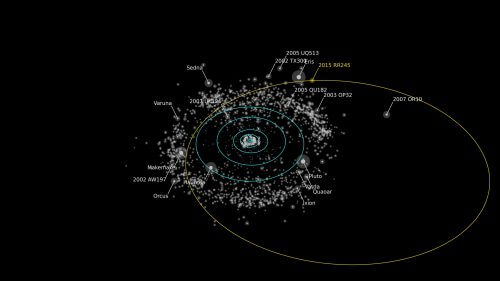The diameter of 2015 RR245 is about 700 kilometers and its orbit is so elliptical that it approaches the Sun to within 34 astronomical units and recedes to a distance of 120 astronomical units. It happens to be very close to the nearest point in its orbit, which it will reach at the end of the century

Astronomers have discovered a dwarf planet in the Kuiper belt, a ring of icy objects beyond Neptune. But this new world, known as 245 RR2015, is much further from the sun than Pluto, and it orbits the sun once every 700 Earth years, scientists said. For comparison, Pluto completes one revolution around the Sun every 248 Earth years.
"The icy worlds beyond Neptune formed like the planets near the Solar System and then drifted away." says discovery team member Michelle Bannister, from the University of Victoria in British Columbia. They allow us to piece together the history of the solar system. "But almost all of these icy worlds are small and faintly luminous, so it's really exciting to find a dwarf planet that's big and bright enough for us to study in detail," Bannister added.
The exact size of 2015 RR245 is still unknown, but researchers estimate it to be 700 km wide. Pluto is the largest inhabitant of the Kuiper belt, with a diameter of 2,371 km. The object was discovered by the Canada-France-Hawaii Telescope in Hawaii that imaged it in September 2015 as part of the ongoing OSSOS survey of the origins of the outer solar system.
"We saw on the screen a point of light that moved so slowly, and therefore it was clear that the orbit of the object was twice the distance of Neptune from the Sun.
OSSOS has discovered more than 500 objects beyond Neptune's orbit, but 245 RR2015 is the first dwarf planet the survey has found, scientists say.
Dwarf planets are massive enough to hold themselves together by their own gravity but they have not "neighbored" other objects. This is what distinguishes them from "normal" planets such as Earth and Saturn.
This definition, which was established by the International Astronomical Union in 2006, led to the reclassification of Pluto as a dwarf planet, a decision that caused great controversy among astronomers.
Astronomers are still working out the details of 245 RR2015's extreme elliptical orbit, and it appears to approach the Sun as close as 34 AU and as far away as 120 AU. An astronomical unit is the distance between the earth and the sun - 150 million km. It should reach its closest point to the sun in 2096, the researchers said.
2015 RR245 – has not yet received an official name. Other dwarf planets confirmed in the Kuiper Belt region include Pluto, Eris, the Omiya and Maka-Maka. Other objects in this distant realm, including Sadna, Quasar, and 2007 OR10, likely meet the criteria for dwarf planet definition, and confirmation is expected in the coming years.

4 תגובות
How would you call it an accent of position? Of course, it doesn't matter if they call him Yossi or M.
The interesting question is how many like him there are or if he is unique. Its being at the greatest distance yet, focuses attention on observing whether there is another star belt. When Kuiper came up with the idea of the belt I think in the sixties, he thought it was no longer there because the fixed planets had waved the belt away. deflected outwards. About 30 years passed and the theoretical belt was discovered and it is there. This is what caused the declaration that Pluto is not a planet.
The discovery of the Kuiper belt revealed that there is a shell of stars with strong imagination that surrounds the solar system like an electron cloud in an atom. After discovering many stars there, the shell becomes something real. First it pushed the boundaries of the solar system beyond what was thought to be significant gravity. If there is another shell, it is fascinating and requires study. Why two separate shells and why there. That's how science works. You discover something new and look for a fit with the theories and discover another thing, then ask if there is one further away and so on.
What does it matter how they define it?
It is not interesting at all the classification of a large or small rock. Their characteristics are interesting.
For my part, let them call it Planet Anancy. Does it change anything?
If Pluto is not called a planet despite its size, because of its belonging to the solar system, what will the new planet be called in the end. If he is a planet why not the big Pluto. The scientists are interested in knowing if there is another belt besides the Kuiper, so perhaps I guess they will now look for a disk structure or a spherical shell of objects at an equal distance from the Sun. It's all one solar system and so complex.
Father you are not resting. strength